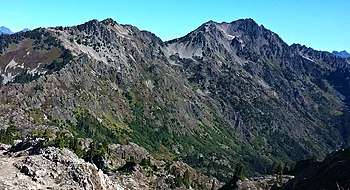Mount Henderson (Washington)
Mount Henderson is a 6,003 ft (1,830 meter) mountain summit located in the Olympic Mountains, in Mason County of Washington state.[3] It is situated on the shared boundary of Olympic National Park with Mount Skokomish Wilderness. Its nearest higher peak is Mount Skokomish, 0.91 mi (1.46 km) to the east-northeast.[1] Precipitation runoff from the mountain drains into the Hamma Hamma River and Skokomish River. The mountain's name honors Louis Forniquet Henderson (1853-1942), a pioneering botanist and mountaineer who accompanied Lieutenant O'Neil on his 1890 expedition into the Olympic Mountains.[4]
| Mount Henderson | |
|---|---|
 Mt. Henderson (left) and Mt. Skokomish (right) seen from the south at Mt. Gladys | |
| Highest point | |
| Elevation | 6,003 ft (1,830 m) [1] |
| Prominence | 323 ft (98 m) [1] |
| Parent peak | Mount Skokomish (6,434 ft) |
| Coordinates | 47°35′13″N 123°18′46″W [1] |
| Geography | |
 Mount Henderson Location of Mount Henderson in Washington  Mount Henderson Mount Henderson (the United States) | |
| Location | Mason County, Washington, United States |
| Parent range | Olympic Mountains |
| Topo map | USGS Mount Skokomish |
| Geology | |
| Age of rock | Eocene |
| Climbing | |
| Easiest route | Hiking via Mt. Gladys[2] |
Climate
Mount Henderson is located in the marine west coast climate zone of western North America.[5] Most weather fronts originate in the Pacific Ocean, and travel northeast toward the Olympic Mountains. As fronts approach, they are forced upward by the peaks of the Olympic Range, causing them to drop their moisture in the form of rain or snowfall (Orographic lift). As a result, the Olympics experience high precipitation, especially during the winter months. During winter months, weather is usually cloudy, but, due to high pressure systems over the Pacific Ocean that intensify during summer months, there is often little or no cloud cover during the summer. Because of maritime influence, snow tends to be wet and heavy, resulting in avalanche danger.
Geology
The Olympic Mountains are composed of obducted clastic wedge material and oceanic crust, primarily Eocene sandstone, turbidite, and basaltic oceanic crust.[6] The mountains were sculpted during the Pleistocene era by erosion and glaciers advancing and retreating multiple times.
References
- "Mount Henderson". Peakbagger.com.
- Mount Henderson at climbersguideolympics.com
- {{cite gnis | id =1520718 | name =Mount Henderson | accessdate =2020-01-16}}
- Olympic Mountains: A Climbing Guide, Olympic Mountain Rescue, Fourth Edition, 2006, The Mountaineers Books, page 60
- Peel, M. C.; Finlayson, B. L. & McMahon, T. A. (2007). "Updated world map of the Köppen−Geiger climate classification". Hydrol. Earth Syst. Sci. 11. ISSN 1027-5606.
- Alt, D.D.; Hyndman, D.W. (1984). Roadside Geology of Washington. pp. 249–259. ISBN 0-87842-160-2.
External links
- Weather: Mount Henderson
- Mount Skokomish Wilderness U.S. Forest Service
- "Olympic National Park". National Park Service.